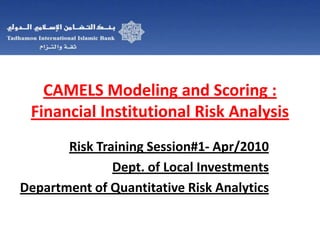Camels Modeling
•Télécharger en tant que PPTX, PDF•
5 j'aime•8,961 vues
Signaler
Partager
Signaler
Partager

Recommandé
Contenu connexe
Tendances
Tendances (20)
Chapter 3 - Risk Management - 2nd Semester - M.Com - Bangalore University

Chapter 3 - Risk Management - 2nd Semester - M.Com - Bangalore University
IRAC NORMS (INCOME RECOGNITION & ASSET CLASSIFICATION AND PROVISIONING NORMS)

IRAC NORMS (INCOME RECOGNITION & ASSET CLASSIFICATION AND PROVISIONING NORMS)
En vedette
En vedette (19)
FINAL DRAFT Starbucks Financial Analysis Term Paper

FINAL DRAFT Starbucks Financial Analysis Term Paper
Assessment of performance of public sector banks under camel framework

Assessment of performance of public sector banks under camel framework
Camelman Dreaming and the Children First Foundation

Camelman Dreaming and the Children First Foundation
Similaire à Camels Modeling
Similaire à Camels Modeling (20)
What is this Project’s Objective This project is designe.docx

What is this Project’s Objective This project is designe.docx
Training FUTURUM : FINANCIAL STATEMENTS ANALYSIS, Jakarta

Training FUTURUM : FINANCIAL STATEMENTS ANALYSIS, Jakarta
“Over” and “Under” Valued Financial Institutions: Evidence from a “Fair-Value...

“Over” and “Under” Valued Financial Institutions: Evidence from a “Fair-Value...
Key Ratios - DefinitionsKEY FINANCIAL STATEMENT RATIOSrev. 3-19-20.docx

Key Ratios - DefinitionsKEY FINANCIAL STATEMENT RATIOSrev. 3-19-20.docx
Camels Modeling
- 1. CAMELS Modeling and Scoring :Financial Institutional Risk Analysis Risk Training Session#1- Apr/2010 Dept. of Local Investments Department of Quantitative Risk Analytics
- 3. A for Asset Quality
- 4. M for Management Capacity
- 5. E for Earnings Base
- 6. L for Liquidity Availability
- 11. As per Basel II Capital Accord , the minimum CAR of a commercial bank should be at least 8.00%
- 13. Calculate capital growth rate of the bank
- 14. Calculate and compare CAR % ratios with local regulatory requirements
- 17. Bad Loan Coverage Ratio should strictly not be less than 1.00 and ideally at least upto 1.5x.
- 19. Portfolio of securities should be analyzed as per their accounting classification and proportion of total investments
- 20. Operating income should be separately analyzed from total earnings after tax deductions
- 22. Well qualified staff at banks always add values to the latter’s brand equity, service quality and market reputation
- 24. Group Support Ratings are a sign of Sponsor strength and group management quality; hence brand equity and management quality of the group to which the bank may belong, should also be assigned scores
- 27. ROE - is the Return on Equity and also the opportunity costs of providing funds to different arms of the bank .Higher ROE should be assigned a higher score
- 29. Fee Income to Net Income ratio should be analyzed separately
- 31. ROE – Return on Equity should be analyzed in light of WACC – Weighted Average Cost of Capital.
- 33. All return ratios should be assigned scores PIT –(Point in Time) and credit risk view should not ignore TTC – (Through the Cycle) performances
- 34. Return ratios and indicators should be assigned scores in light of other balance sheet ratio trends to check linearity and correlation with other risk drivers .
- 36. Majority of the failed banks in our times, had defaulted on fixed rate commitments due to liquidity mismanagement
- 38. Banks with higher CAR have higher liquidity resources and vice versa
- 40. Liquid assets proportion to liquid liabilities ascertains short term funding position
- 42. Higher availability of liquid assets in relation to total assets should be assigned a higher score
- 45. Banks have witnessed an increase in loan defaults due to interest rate hikes
- 46. Overall increase in market risks may reduce CAR – Capital Adequacy Ratio and default probability
- 48. If Weighted Duration of Assets exceeds Weighted Duration of Liabilities , than the bank has a Duration surplus and vice versa
- 50. A higher score should be assigned to duration surpluses (WDA>WDL) in a falling↓ interest rate environment
- 52. Country Risk can be quantified using External Ratings
- 54. Social issues should be analyzed with its impact on banking industry
- 56. All factors that contribute to FX price changes and impact translation losses should also be studied
- 57. Historical Macroeconomic trends should be regressed
- 59. External Debt to GDP ratio should be on the lower side. The lower the ratio the higher the score to be assigned and vice versa